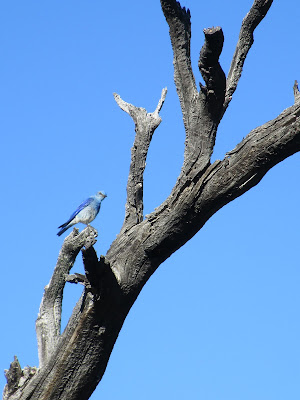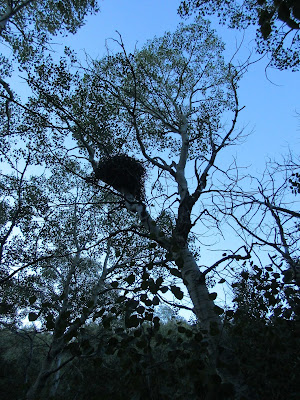Nevada Bird Count Tour 7 Part 3
At the end of the last birding tour of the season, it's tradition that the crew head to some incredible place of Jen's choosing to spend a couple days birding, relaxing, and having campfire cookouts. This year the location was Onion Valley Reservoir, nestled in the Pine Forest Range a bit farther north than our Black Rock survey sites. The crew had come here at the end of season 2 years ago and we'd heard good things about this beautiful site (including the fact that one of the NBCers had a Long-tailed Jaeger on the reservoir that year), so we were excited to see it. Would it really be that much different from the Black Rock/High Rock we'd spent weeks at this season?
 |
| Camp at Onion Valley Reservoir |
On these season end events, each of the crew does have to work in that they need to collect some sort of data, but they are 'fun' surveys. Everyone got the choice of surveying a pre-existing transect, create their own transect, or (the best option) survey a 1km x 1km atlas square. The atlassing essentially entails picking a square of cool country out on the map and then birding it the next day, trying to maximize your species list and track down as many baby birds as you can. No time constraints, distance estimation, temperature measurements etc., just straight birding! Always a refreshing way to end the season.
For myself I chose a section over the closest ridge from camp, with some high-ish peaks on my plot in the hopes of getting some Coniferous Forest habitat. Proper coniferous forest, with Limber Pine and the like as opposed to Pinyon-Juniper, is a real rarity on the NBC, and I was hoping it would produce some fun birds. For instance, the last time the crew was here they found some breeding Hammond's Flycatchers, one of the few places in the state that has them.
That morning, July the 11th, we woke up to temperatures below freezing, which surprised me not only for the time of year but also that we were only a bit over 7000ft. It was tough crawling out of bed, and even tougher clambering up the steep slope with thick vegetation before I even got to my square. It was a pretty rough start, and I had thoughts of just turning around since it was only 'fun' data, but I'm glad I didn't. Even before it warmed up, I was rewarded with some breathtaking views of the reservoir and surrounding hills. A Golden Eagle drifted over the peaks in the dawn light.
 |
| Onion Valley Reservoir at dawn |
 |
| Misty Mountains |
But eventually the temperature warmed up, my bones thawed out, the birds became a little more active, and my spirits improved. Climbing up high enough I did eventually reach the Limber Pine, where a group of Clark's Nutcrackers with their fuzzy babies provided some entertainment. I got to watch some 'cracking nuts' as well.
 |
| Limber Pine and a snow patch clinging on |
And the views got even better as I got higher.
Near the top a family of Mountain Bluebirds was fun to watch. Here's the male blending into the sky:
 |
| Male Mountain Bluebird |
And one of the three hungry babies:
 |
| Fledgeling Mountain Bluebird |
As they often are on these high elevation sagebrush patches, the wildflowers were lovely to see as well.
 |
| Castilleja and other wildflowers in the sage |
The square was quite varied in its habitats, which was great for atlassing. The higher elevations were mostly Limber Pine as I'd mentioned, but in places the hilltops were covered with Mountain Mahogany. These patches looked great for Virginia's Warbler, a bird I've encountered once and that remains on my 'heard only' list, but none made there presences known. Ned and Bobby had similar patches on their squares but struck out as well.
 |
| Mountain Mahogany patch |
As I made my way down from the peak, I had my highlight sighting of the morning and possibly the season. I was coming the hillside when 10m away a large animal burst out from underneath a pine in front of me. In that first split second I thought by the tan colour it was a Mule Deer, but then its shorter profile, smooth bounds, and long, snake-like tail trailing behind it became clear. The Mountain Lion made one, two, three, four, five bounds of increasing length before disappearing into a thick stand of young aspen. I'd seen their tracks numerous times both of the last two seasons, and they can be found almost anywhere in the mountains of the state, but it takes a lucky moment like that to actually come across one of these majestic cats. While the view was brief, and I didn't get to see its face, coming across my lifer cat at 10m was pretty exhilarating and kept my pumped for the next while. It was running away downslope and I'm not typically too worried about predators (particularly during the bright light of day, as it was now 8:00 or something), but I didn't follow it to try to get a better look haha.
Further down-slope I came back into the aspens, with some creeks winding their way through and a few patches of open sage. Along one of those creeks an angry Slate-coloured Fox Sparrow eventually lead my to its silent fledgeling, and a stealthy Orange-crowned Warbler chipped as it carried food to its own. A pair of Warbling Vireos likely also had young around, but they were being very uncooperative as I watched them and I wasn't able to confirm their breeding.
The lichens on the dead pine are always striking.
Lower down yet I discovered a series of seepy meadows surrounded by willows. A local pair of Red-naped Sapsuckers had put wells into many of the willows, and this attracted wildlife like California Sister butterflies.
 |
| California Sister on Red-naped Sapsucker wells |
Some excited chirping and buzzing lead me to a family of Rufous Hummingbirds, a female with 3 young. This tour had been interesting with finds of this species, because 3 days before Ned had found a family down on MR-SummerCamp, and the day before Bobby and Kaitlin had found a similar group along BlackRockMahogany. What makes these finds so interesting is that this species has never been confirmed breeding in Nevada. Now, Rufouses (Rufi?) do start migrating early, so our birds could very well have been post-breeding migrants, but the fact that many were still hanging around in their family groups was notable. Perhaps the fact that no one on the crew had any sightings of this species on either of our previous tours up here lends more evidence to these birds not being breeders, but it'll definitely be something for future crews to look our for.
 |
| Juvenile Rufous Hummingbird |
 |
| Mountain meadow |
When we got to camp everyone shared their finds from the morning. I have to say my Mountain Lion took the cake, but Bobby found a Northern Goshawk nest on his plot which is pretty high up on the list of awesome. At last season's end-of-season get together I found my first (and only) goshawk nest in the Toiyabes, and I was pretty keen on seeing another one. Kayla had never seen a goshawk, and Ned was always down to track down one of these awesome raptors, so the following morning before heading back south we quested to Bobby's atlas square to find these mighty accipiters.
After driving towards Blue Lake we navigated to the UTM Bobby had given us and quickly found the nest. Bobby had said that the young were fledged but still hanging around the nest while he was there, but on our visit the forest was quiet an the birds were no-where to be found. We were hoping the birds might make it easy for us when they discovered us, coming in screaming with talons drawn, but they didn't materialize so we hiked out of the stand into the meadow above with the hopes of a better view.
 |
| Northern Goshawk nest |
On our way out a massive accipiter did pass us in the dim dawn light which, through the bins, I was barely able to make out the gray mantle and white eyebrow of an adult Gos. Unfortunately after we made it to the meadow and set up to wait for another fly-by the birds did not cooperate. It was a lovely meadow though, and the sun warmed us on the chilly morning.
 |
| Shadows of goshawk searchers |
After packing up camp we started the long drive back south. Coming down from the range we had a few Chukar, one of which teed up on a rock for us.
At the turn-off for the main road we made a stop at Gridley Lake, a mostly dry salty playa, to try for Snowy Plovers. A potential lifer for Ned, Kayla and I had only seen the species a few times before so, so we hiked down to the shore to check it out. Sure enough, the plovers were there, chasing the clouds of gnats across the saline puddles of the lakebed. In a distance patch of water there was a much larger group of peeps, Western and Least from what I could tell, accented by a few tall Avocets and Willets.
 |
| Gridley Lake |
On the way out Ned caught this big Desert Horned Lizard.
 |
| Ned with his Desert Horned Lizard |
And so ended out last birding tour of the NBC. One heck of a season with an amazing crew, I'll definitely miss Nevada's deserts and mountains, and the birds, critters, and people I met there. Next year I don't see myself returning for a third season in a row, but maybe some year down the line I'll find myself coming back to this great project.
After the season's end Ned, Kayla, Kelly (from GBBO's Crescent Dunes Project) and I headed down to Southeast Arizona, where in my 5 days with them and 7 days on my own tallied 49 life birds, some 20 new herps, and saw loads of awesome things. However, we'll see when I get around to recounting those adventures, since when this posts I'll be up at James Bay for to survey shorebirds for 4 weeks, after which I'll be at banding at Thunder Cape Bird Observatory for another 5 weeks. Too much content and no time to write it! Anyhow, thanks for reading along with my wanderings in Nevada, and hopefully when I get the time I'll be able to get some photos and stories up about the next legs of my travels.
After the season's end Ned, Kayla, Kelly (from GBBO's Crescent Dunes Project) and I headed down to Southeast Arizona, where in my 5 days with them and 7 days on my own tallied 49 life birds, some 20 new herps, and saw loads of awesome things. However, we'll see when I get around to recounting those adventures, since when this posts I'll be up at James Bay for to survey shorebirds for 4 weeks, after which I'll be at banding at Thunder Cape Bird Observatory for another 5 weeks. Too much content and no time to write it! Anyhow, thanks for reading along with my wanderings in Nevada, and hopefully when I get the time I'll be able to get some photos and stories up about the next legs of my travels.
















